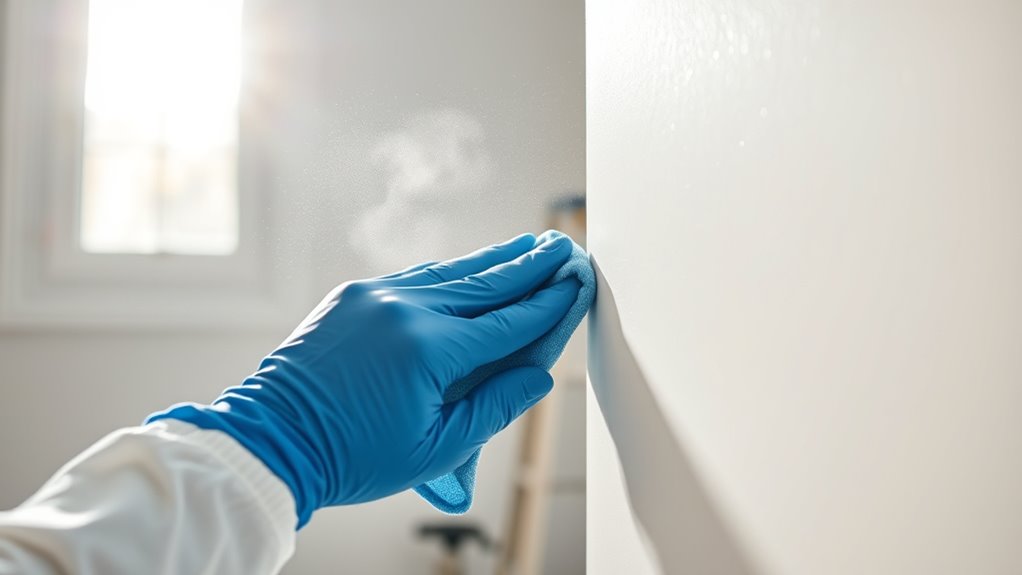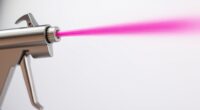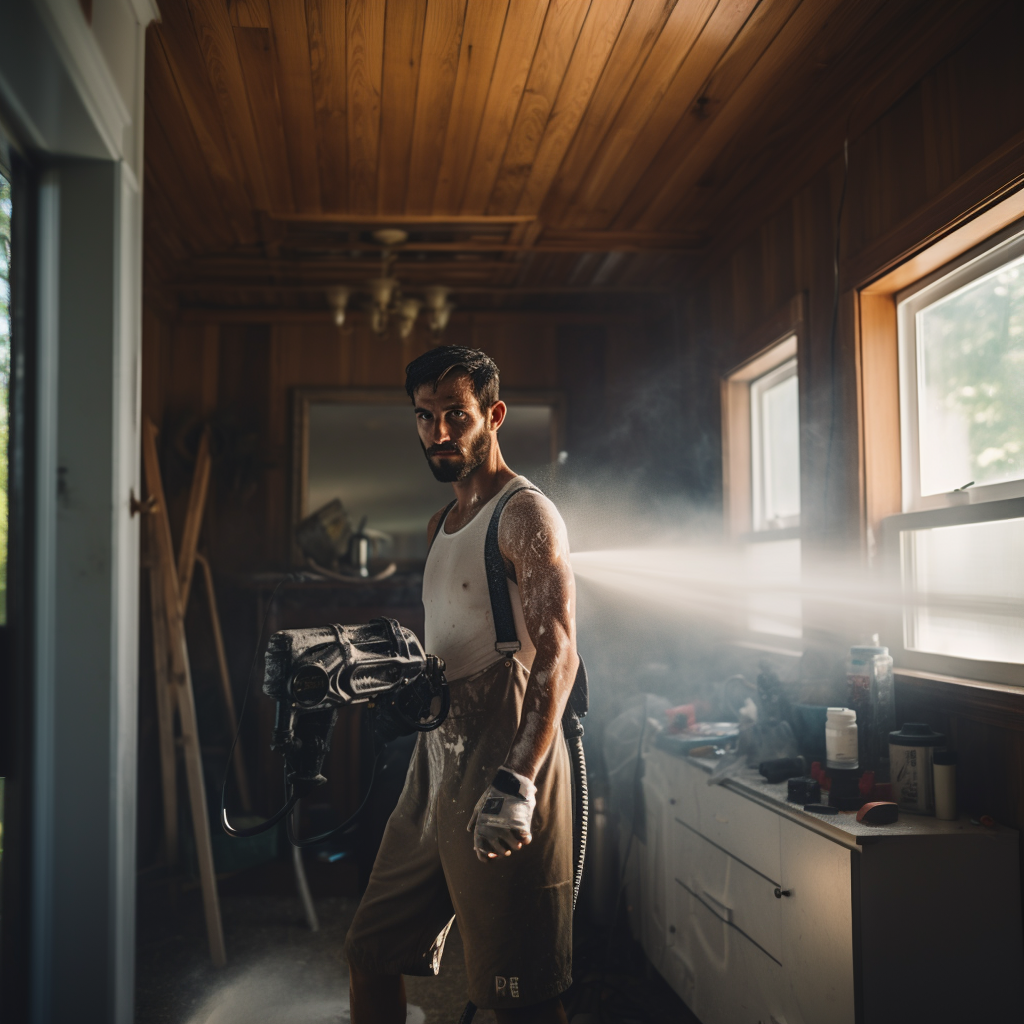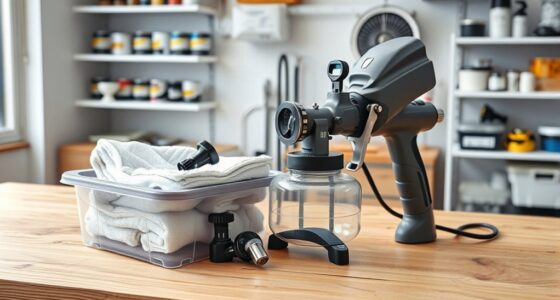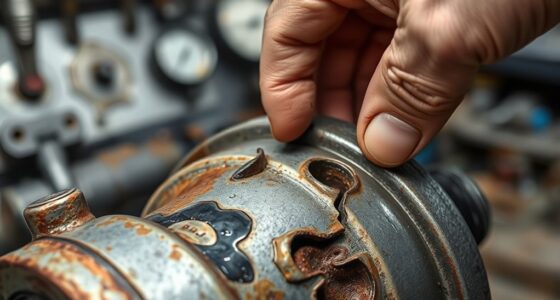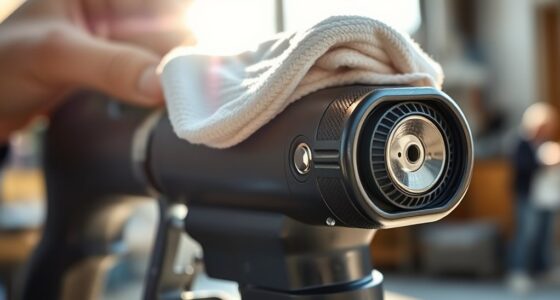To avoid overspray, plan your workspace carefully by covering furniture and floors with drop cloths or plastic sheeting, and use painter’s tape for sharp lines. Choose the right tools, like quality spray guns or brushes, and practice proper technique with controlled, steady motion. When overspray happens, act quickly by gently wiping the area with a damp cloth or solvent, and repair any spots later with touch-up methods. Keep exploring for more insider tips on perfecting your paint job.
Key Takeaways
- Use protective barriers like drop cloths, plastic sheeting, and painter’s tape to prevent overspray from reaching unintended surfaces.
- Calibrate spray equipment and select appropriate nozzle sizes to control paint flow and reduce excess spray.
- Practice mindful application techniques, such as maintaining proper distance and steady movement, to minimize overspray during painting.
- Immediately stop spraying and gently wipe overspray with a damp cloth or use appropriate solvents for quick cleanup.
- Repair overspray damage by light sanding, matching paint, and applying thin, blended coats for a seamless finish.
Preparing Your Workspace to Minimize Overspray
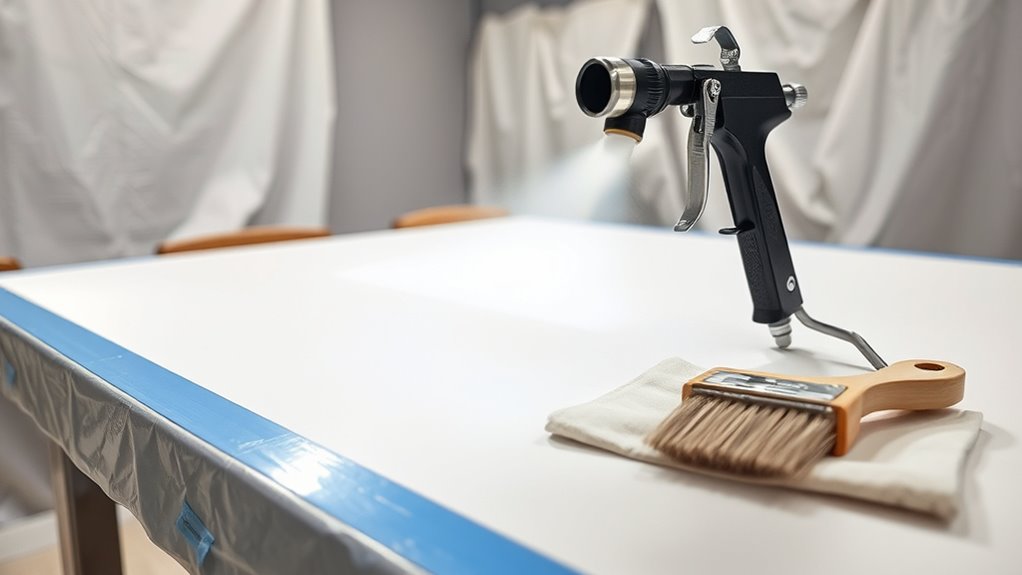
Have you ever noticed how paint overspray can turn a clean workspace into a mess? To prevent this, start with proper workspace organization. Clear the area of unnecessary items and cover furniture or fixtures with drop cloths. This minimizes surfaces that can be contaminated and makes cleanup easier. Next, optimize ventilation by opening windows and using fans to direct airflow away from other areas. Good ventilation helps disperse overspray particles quickly, reducing their spread. You might also consider setting up a designated painting zone with barriers or plastic sheeting. Keeping your workspace organized and well-ventilated not only minimizes overspray but also creates a safer, more efficient environment. Proper ventilation techniques and careful planning are essential to avoid contamination and ensure a smooth painting process. Using self watering plant pots in your workspace can also help keep the area tidy and reduce water spills that could complicate cleanup. Employing protective coverings such as painter’s tape and plastic sheeting can further limit overspray escape and protect surrounding surfaces. Incorporating professional equipment like spray booths or air filtration systems can significantly enhance overspray control and improve overall results. Additionally, maintaining a clean and organized workspace aligns with best practices in ethical painting, ensuring safety and quality. These steps ensure your project stays neat and manageable from start to finish.
Choosing the Right Painting Tools and Equipment
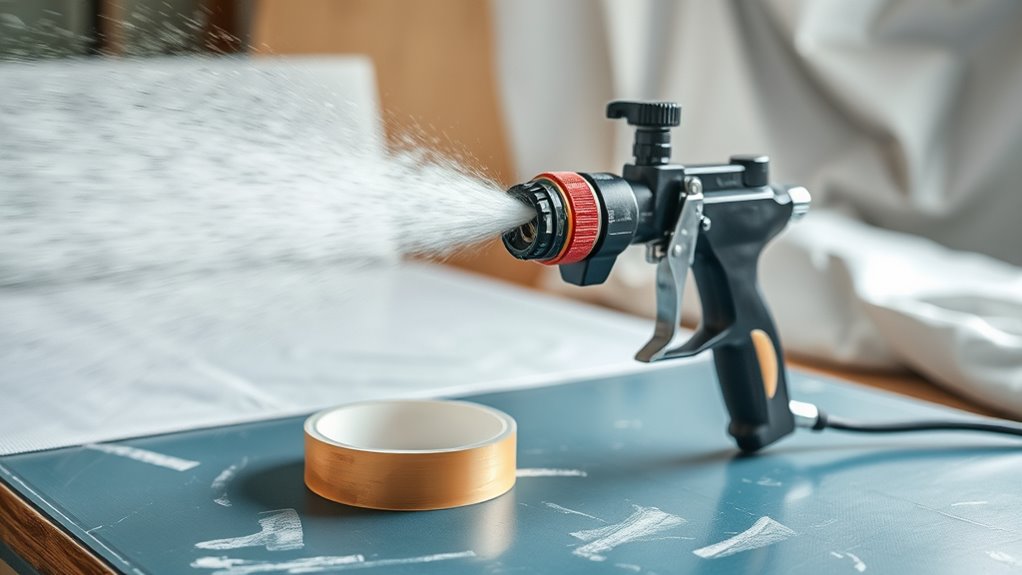
Selecting the right painting tools and equipment is essential for achieving a smooth, professional finish while minimizing overspray. Start with brush selection; choose brushes that suit your project, such as angled brushes for corners and flat brushes for large surfaces. Proper brush selection helps control paint application and reduces drips. Equally important is ensuring the paint consistency is correct—thinning your paint if it’s too thick allows for easier, more even coverage with less splatter. Consider using high-quality spray guns or rollers designed for your specific project to further reduce overspray. Using the right tools makes your job easier and results in cleaner lines and fewer paint droplets outside your target area. Proper equipment choice ultimately saves you time and effort during cleanup. Additionally, selecting the appropriate tip size for your spray gun ensures optimal spray pattern and finish quality, reducing the chances of overspray and paint wastage.
Techniques for Precise and Controlled Painting

To attain clean, precise results, you need to master masking and taping techniques that safeguard surfaces from overspray. Using proper spray equipment also helps control paint flow and minimize mess. Together, these methods ensure your project stays neat and professional-looking. Applying skincare patches before painting can serve as a barrier to protect sensitive areas from accidental splatters or drips. Incorporating mindfulness and presence during your work can help you stay attentive and reduce mistakes.
Masking and Taping Techniques
Effective masking and taping are essential for achieving clean, precise paint lines and preventing overspray. Proper technique ensures smooth edge painting and easier tape removal, reducing touch-ups later. Start by cleaning surfaces thoroughly to guarantee good adhesion. Use painter’s tape with a low adhesion level for delicate edges. Press down firmly along the tape edges to prevent paint bleed. When applying tape, work slowly and smoothly, avoiding wrinkles or gaps. For sharp lines, consider using a masking knife to trim excess tape. Carefully remove the tape at a 45-degree angle once the paint is slightly dry to prevent smudging. Proper masking and taping minimize overspray and assure crisp, professional results. Additionally, understanding the paint application process can help prevent overspray and achieve a more polished finish. Maintaining emotional alignment during the painting process—such as staying focused and patient—can also contribute to more consistent results. Recognizing the importance of industry trends, such as the latest masking techniques, can further enhance your outcomes.
Using Proper Spray Equipment
Using proper spray equipment is key to achieving a smooth, professional finish with minimal overspray. Start by ensuring your spray gun is well-calibrated; this guarantees consistent paint flow and spray pattern. Proper spray gun calibration helps you control the amount of paint released, reducing excess that can lead to overspray. Next, select the right nozzle size for your project—smaller nozzles produce finer spray for detail work, while larger nozzles cover broader areas efficiently. Always test your spray pattern on a scrap surface before starting your project to fine-tune settings. Using the correct equipment and adjustments not only improves finish quality but also minimizes paint waste and overspray, making your painting process cleaner, safer, and more effective. Additionally, employing adjustable settings allows you to better control spray pattern and flow, further reducing overspray. Incorporating techniques from sound design such as controlled application methods can also contribute to more precise spray control and cleaner results.
How to Protect Surfaces and Surroundings During Painting

Before you start painting, make sure to cover nearby items with drop cloths or plastic sheeting to protect them from overspray. You can also set up protective barriers, like painter’s tape or cardboard, to shield surfaces you don’t want to get paint on. Taking these simple steps keeps your surroundings clean and minimizes cleanup later. Additionally, using protective barriers can prevent paint from reaching unintended surfaces and make cleanup easier afterward. For added safety, consider choosing a properly ventilated workspace to reduce inhalation of paint fumes and ensure better air quality during your project. Proper grocery savings strategies can also help you allocate resources for necessary painting supplies or improvements.
Cover Nearby Items
To prevent accidental paint damage, it’s essential to cover nearby items and surfaces before starting your project. Using drop cloths and plastic sheeting helps protect furniture, floors, and fixtures from overspray. Draping these covers over delicate items creates a barrier that catches stray paint. Make sure to secure the edges with painter’s tape to keep everything in place. Consider layering plastic sheeting over larger surfaces for added coverage, especially in high-traffic areas. Keep small items, such as lamps or picture frames, covered or moved out of the way. Proper protection reduces cleanup time and keeps your space looking professional. Additionally, understanding the impact of contrast ratio can help you better plan your painting setup for optimal results, ensuring consistent lighting and color accuracy. Proper surface preparation and protective measures are essential for a clean finish, preventing paint from reaching unintended areas. Remember, thorough coverage now saves you from potential frustration and extra work later. Regular maintenance and cleaning techniques also contribute to a smoother painting process and better results.
Use Protective Barriers
Protecting your surfaces and surroundings during painting is essential to prevent damage and overspray. Use drop cloths to cover floors, furniture, and fixtures, ensuring they’re secured to avoid slipping. For larger or more delicate areas, plastic sheeting offers a versatile barrier against overspray and drips. Tape the edges of the sheeting to walls or furniture for a snug fit. This creates a physical barrier that keeps paint from reaching unwanted areas. When setting up, make sure the barriers are tight and well-secured. Combining drop cloths and plastic sheeting provides extensive coverage, minimizing cleanup and protecting your belongings. Using these protective barriers helps you work efficiently, knowing your surroundings are shielded from paint overspray.
Immediate Steps to Take When Overspray Occurs
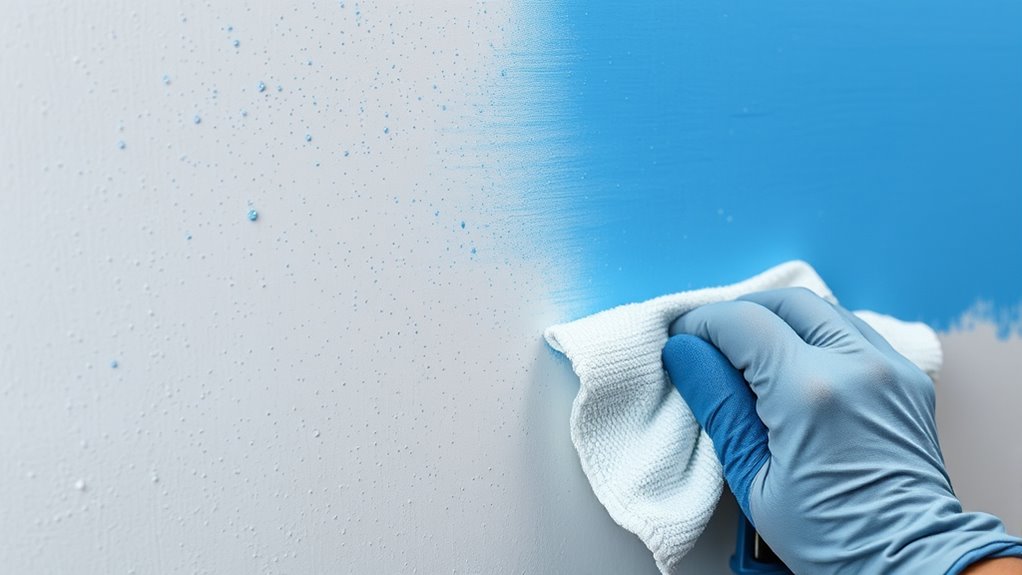
When overspray happens, acting quickly can prevent it from settling further and causing more damage. Your first step is to stop the spray immediately. Use a clean, damp cloth to gently wipe nearby surfaces, preventing paint from drying and sticking. Adjust your brush techniques to reduce overspray—hold the brush closer and control your movement. Check the paint consistency; thinning it slightly can help minimize splatter. If overspray lands on unintended areas, immediately dab with a cloth instead of rubbing, which can spread the paint. Keep a spray bottle of water or solvent nearby to dampen overspray for easier removal. Additionally, understanding paint application techniques that can influence overspray can help you take precautions to protect your surfaces from unintended paint dispersal. Proper sprayer maintenance and adjusting pressure settings can also reduce the likelihood of overspray occurring. Being aware of airflow control methods during painting can further help in minimizing overspray and ensuring a cleaner finish. Proper surface preparation and using protective masking can also significantly reduce the chances of overspray reaching unwanted areas. By acting swiftly, you can limit damage and set the stage for effective cleanup later.
Effective Methods for Cleaning Paint Overspray From Different Surfaces
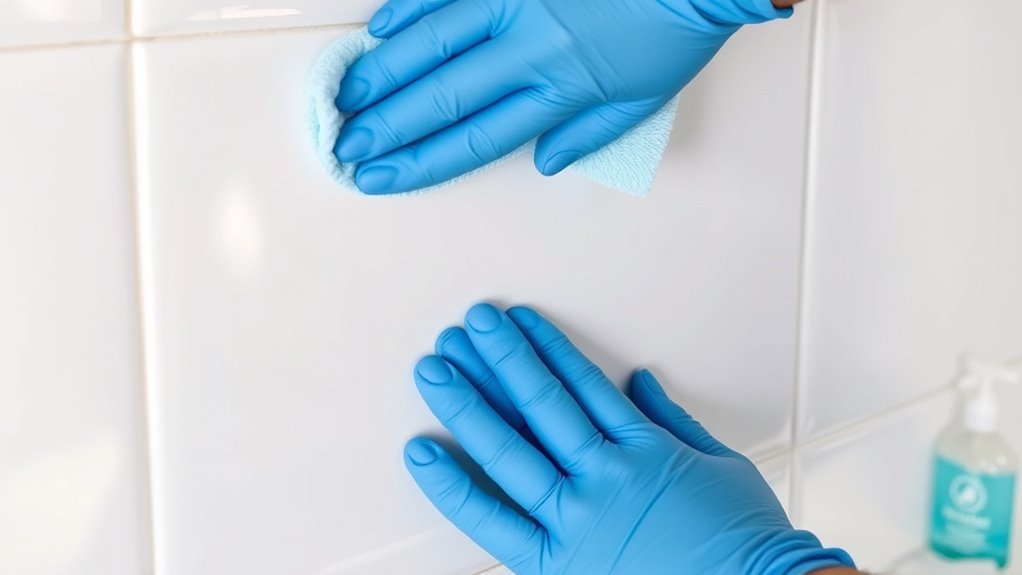
Different surfaces require different cleaning approaches to effectively remove paint overspray without causing damage. For smooth surfaces like glass or metal, use a gentle paint remover or solvent, such as mineral spirits or acetone, after surface preparation by testing a small area first. For painted walls or drywall, lightly scraping or using a soft cloth with warm, soapy water can often suffice; harsher chemicals might damage the finish. On concrete or brick, pressure washing combined with a specialized cleaner works well, but ensure surface preparation involves removing loose debris beforehand. Always identify the surface type before starting paint removal, and select cleaning methods accordingly. Proper surface preparation assures you remove overspray efficiently without harming the underlying material.
Tips for Repairing and Touching Up Accidental Paint Spots

Accidental paint spots can be frustrating, but quick and careful repairs can restore your surfaces seamlessly. To start, gently sand the area to smooth out any uneven brush strokes. Match the paint color as closely as possible and apply thin layers, blending carefully to achieve even color blending. Use a fine brush for precise touch-ups, feathering the paint into surrounding areas to avoid harsh edges. Allow each coat to dry completely before adding more. If needed, lightly sand again for a seamless finish. Patience is key to preventing noticeable brush strokes or color mismatches. Proper surface preparation and understanding the celebrity transformations involved in paint repair can help you achieve a professional look. With careful handling, your surface will look flawless again, and no one will notice the repair.
Gently sand, match paint, apply thin coats, and feather edges for flawless touch-up repairs.
- Use a small, high-quality brush for precise application
- Feather the edges for better color blending
- Apply thin, even coats to avoid brush strokes
- Sand lightly between coats for a smooth finish
Frequently Asked Questions
Can Paint Overspray Be Removed From Clothing or Skin?
Paint overspray can often be removed from clothing or skin with prompt paint removal techniques. For clothing, gently scrape off excess paint and use stain treatment or a solvent like acetone or rubbing alcohol, testing first for fabric safety. On skin, wash immediately with soap and warm water, and apply a gentle oil or commercial paint remover if needed. Acting quickly helps prevent long-lasting stains and makes paint removal easier.
What Safety Gear Is Recommended During Overspray Cleanup?
Think of your safety gear as your armor during overspray cleanup. You should wear personal protective equipment like gloves, goggles, and a respirator mask to shield your skin, eyes, and lungs from harmful paint particles. Follow safety precautions by ensuring the gear fits properly and is in good condition. This way, you stay safe and avoid unwanted paint contact, turning a messy job into a secure and efficient cleanup.
How Long Does Paint Overspray Typically Take to Dry?
Paint overspray typically takes anywhere from 30 minutes to a few hours to dry, depending on environmental factors like temperature, humidity, and airflow. You should check the paint’s drying time on the label for accuracy. Keep the area well-ventilated and avoid touching the surface until it’s fully dry to prevent smudging or damage. Patience guarantees the best results, especially in varying environmental conditions.
Are Environmentally Friendly Methods Available for Cleaning Overspray?
You might find it surprising, but eco-friendly methods for cleaning paint overspray do exist. You can use eco-friendly solvents and biodegradable cleaners that effectively remove overspray without harming the environment. These options are safe for your home and reduce chemical waste. By choosing biodegradable cleaners, you help protect waterways and wildlife, making your cleanup process both effective and environmentally responsible. It’s a simple step towards greener painting practices.
Can Professional Services Be Hired to Remove Stubborn Overspray?
You can definitely hire professional services for stubborn overspray. Overspray specialists offer professional removal, ensuring your surfaces are restored efficiently and safely. They use advanced techniques and eco-friendly products, minimizing damage and environmental impact. By engaging overspray specialists, you benefit from expert knowledge and proper equipment, making the cleanup process faster and more effective. Trust these professionals to handle even the toughest overspray, saving you time and effort.
Conclusion
With a steady hand and the right tools, you can tame paint overspray like a skilled artist controlling their brush. Think of it as guiding a gentle breeze away from delicate blooms—your careful preparation and quick cleanup keep your masterpiece pristine. Remember, every accidental splash is just a chance to sharpen your skills. With patience and the right techniques, you’ll turn painting mishaps into mere strokes on the canvas of your home improvement journey.
Franz came aboard the Paint Sprayer Zone team with a background in both journalism and home renovation. His articulate writing style, combined with a passion for DIY projects, makes him an invaluable asset. Franz has a knack for breaking down technical jargon into easy-to-understand content, ensuring that even the most novice of readers can grasp the complexities of paint sprayers.
